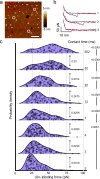Monitoring the binding and insertion of a single transmembrane protein by an insertase
- PMID: 34873152
- PMCID: PMC8648943
- DOI: 10.1038/s41467-021-27315-3
Monitoring the binding and insertion of a single transmembrane protein by an insertase
Abstract
Cells employ highly conserved families of insertases and translocases to insert and fold proteins into membranes. How insertases insert and fold membrane proteins is not fully known. To investigate how the bacterial insertase YidC facilitates this process, we here combine single-molecule force spectroscopy and fluorescence spectroscopy approaches, and molecular dynamics simulations. We observe that within 2 ms, the cytoplasmic α-helical hairpin of YidC binds the polypeptide of the membrane protein Pf3 at high conformational variability and kinetic stability. Within 52 ms, YidC strengthens its binding to the substrate and uses the cytoplasmic α-helical hairpin domain and hydrophilic groove to transfer Pf3 to the membrane-inserted, folded state. In this inserted state, Pf3 exposes low conformational variability such as typical for transmembrane α-helical proteins. The presence of YidC homologues in all domains of life gives our mechanistic insight into insertase-mediated membrane protein binding and insertion general relevance for membrane protein biogenesis.
© 2021. The Author(s).
Conflict of interest statement
The authors declare no competing interests.
Figures





Similar articles
-
Real time observation of single membrane protein insertion events by the Escherichia coli insertase YidC.PLoS One. 2013;8(3):e59023. doi: 10.1371/journal.pone.0059023. Epub 2013 Mar 19. PLoS One. 2013. PMID: 23527078 Free PMC article.
-
Insertion and folding pathways of single membrane proteins guided by translocases and insertases.Sci Adv. 2019 Jan 30;5(1):eaau6824. doi: 10.1126/sciadv.aau6824. eCollection 2019 Jan. Sci Adv. 2019. PMID: 30801000 Free PMC article.
-
The Pf3 coat protein contacts TM1 and TM3 of YidC during membrane biogenesis.FEBS Lett. 2008 Dec 10;582(29):3967-72. doi: 10.1016/j.febslet.2008.10.044. Epub 2008 Nov 6. FEBS Lett. 2008. PMID: 18996118
-
Membrane protein insertase YidC in bacteria and archaea.Mol Microbiol. 2017 Feb;103(4):590-594. doi: 10.1111/mmi.13586. Epub 2017 Jan 3. Mol Microbiol. 2017. PMID: 27879020 Review.
-
YidC as a potential antibiotic target.Biochim Biophys Acta Mol Cell Res. 2023 Feb;1870(2):119403. doi: 10.1016/j.bbamcr.2022.119403. Epub 2022 Nov 23. Biochim Biophys Acta Mol Cell Res. 2023. PMID: 36427551 Review.
Cited by
-
The insertase YidC chaperones the polytopic membrane protein MelB inserting and folding simultaneously from both termini.Structure. 2023 Nov 2;31(11):1419-1430.e5. doi: 10.1016/j.str.2023.08.012. Epub 2023 Sep 13. Structure. 2023. PMID: 37708891 Free PMC article.
-
Probing SARS-CoV-2 membrane binding peptide via single-molecule AFM-based force spectroscopy.Nat Commun. 2025 Jan 2;16(1):6. doi: 10.1038/s41467-024-55358-9. Nat Commun. 2025. PMID: 39747000 Free PMC article.
-
An investigation of the YidC-mediated membrane insertion of Pf3 coat protein using molecular dynamics simulations.Front Mol Biosci. 2022 Aug 15;9:954262. doi: 10.3389/fmolb.2022.954262. eCollection 2022. Front Mol Biosci. 2022. PMID: 36046607 Free PMC article.
-
Mechanistic Insight into the Mechanical Unfolding of the Integral Membrane Diacylglycerol Kinase.JACS Au. 2024 Mar 16;4(4):1422-1435. doi: 10.1021/jacsau.3c00829. eCollection 2024 Apr 22. JACS Au. 2024. PMID: 38665647 Free PMC article.
-
Vastly different energy landscapes of the membrane insertions of monomeric gasdermin D and A3.Commun Chem. 2025 Feb 6;8(1):38. doi: 10.1038/s42004-024-01400-2. Commun Chem. 2025. PMID: 39915622 Free PMC article.
References
-
- Pugsley AP, Francetic O, Driessen AJ, de Lorenzo V. Getting out: protein traffic in prokaryotes. Mol. Microbiol. 2004;52:3–11. - PubMed
-
- Preuss M, Ott M, Funes S, Luirink J, Herrmann JM. Evolution of mitochondrial oxa proteins from bacterial YidC. Inherited and acquired functions of a conserved protein insertion machinery. J. Biol. Chem. 2005;280:13004–13011. - PubMed
-
- Driessen AJM, Nouwen N. Protein translocation across the bacterial cytoplasmic membrane. Annu. Rev. Biochem. 2008;77:643–667. - PubMed
Publication types
MeSH terms
Substances
LinkOut - more resources
Full Text Sources
Molecular Biology Databases

